Achieving a Harmonized Society with Nature
- Efforts to Achieve a Harmonized Society with Nature
- Initiatives to Minimize Impacts on Natural Capital
- Addressing Risks Related to Water and Biodiversity
- Managing Chemical Substances
- Managing Chemical Substances in Our Products
- Managing Chemical Substances in Our Business Operations
- Efforts to Conserve Ecosystems
Efforts to Achieve a Harmonized Society with Nature
Approach & Policy
Our social lives and economic activities depend on numerous benefits (ecosystem services) bestowed by nature, and the loss of biodiversity is becoming recognized as a major economic risk. Nature Risk Rising, published by the World Economic Forum in 2020, notes that the creation of approximately $44 trillion of economic value, or more than half of global GDP, depends on natural capital and ecosystem services at risk due to biodiversity destruction.
Against this backdrop, the Kunming-Montreal Global Biodiversity Framework, adopted at the 15th Conference of the Parties to the United Nations Convention on Biological Diversity (CBD-COP15) held in Montreal, Canada, in December 2022, established 23 global targets with the aim of implementing urgent measures to halt and reverse biodiversity loss in order to put nature on the path to recovery by 2030. Of particular importance to business enterprises are Target 3, which is to conserve at least 30% of terrestrial and water areas through protected areas and OECM*1 (30 by 30 target), and Target 15, which is to ensure that businesses, especially large corporations and financial institutions, assess and disclose risks related to biodiversity, dependencies and impacts on biodiversity, and measures to provide required information to consumers to promote sustainable consumption patterns.
In addition, with heightened interest in ESG investment and financing, a private-sector initiative is growing to require disclosure of biodiversity-related information. The Task Force on Nature-related Financial Disclosures (TNFD) established a disclosure framework for organizations to report and act on nature-related risks with a view to shifting the flow of funds to nature-positive activities. This framework requires companies and financial institutions to assess and disclose risks and opportunities related to natural capital and biodiversity in an appropriate manner.
To achieve a harmonized society with nature, as well as to reflect related global trends, Hitachi assesses and discloses biodiversity-related risks, the dependence, and the impact of business activities overall on biodiversity.
*1OECM: Areas other than protected areas that contribute to biodiversity conservation. Acronym for Other Effective area-based Conservation Measures
Initiatives to Minimize Impacts on Natural Capital
Activities
Materiality
To preserve the ecosystem and achieve a society harmonized with nature to continue to enjoy nature’s benefits, we established targets to minimize our impact on natural capital as part of our long-term environmental targets.
We classify the emission of greenhouse gases and chemical substances into the atmosphere and the generation of waste materials in the course of our business activities as negative impact activities. Providing products and services that contribute to ecosystem preservation and undertaking activities to preserve biodiversity and ecosystems are categorized as positive impact activities. We are working to quantify and minimize the difference between positive and negative impacts by 2050.
Hitachi has adopted two methodologies for our action to reduce negative impacts on natural capital. These are version 2 of the Life-cycle Impact Assessment Method based on Endpoint Modeling (LIME2) and utilization of Japan’s leading inventory database (IDEA v2*1), both of which we use to evaluate our business activities after identifying their negative impacts. As a result, approximately 45% of our negative impacts in fiscal year 2023 were related to climate change. With regard to climate change, we pursue initiatives aimed at creating a decarbonized society. Regarding urban air pollution and resource consumption, certain findings have also come to light in impact assessments concerning raw materials procurement. To this end, we plan to accelerate the pace of efforts intended to achieve a resource-efficient society. To reduce our environmental load further and minimize our impact on natural capital, we will step up a wide range of activities that include increasing the energy efficiency of our products and services, improving factory efficiency, using resources more effectively, and managing chemical substances properly.
To expand positive impact, we engage in social contribution activities, such as forest conservation, and business activities that contribute directly to ecosystem preservation, such as building water treatment plants. We are also studying how to quantify the impact of these activities on the environment.
We estimate the benefits gained through our forest conservation activities (flood prevention, water impoundment, water purification, soil loss prevention, and carbon fixation) on an ongoing basis using evaluation methods commonly used in forestry-related public works projects. We also collect data on forested areas targeted for conservation, which is required to evaluate forest conservation efforts. We surveyed 0.93 km2 of such forested areas in fiscal 2023.
*1IDEA v2: One of Japan’s leading inventory databases required to implement LCAs for calculating negative impacts.
Scope of Negative Impact CalculationsTimetable for Minimizing Impacts
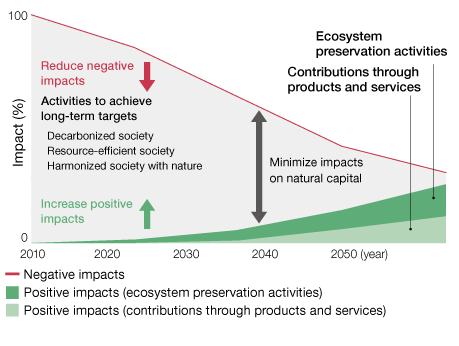
Negative Impacts on Natural Capital (FY2023)
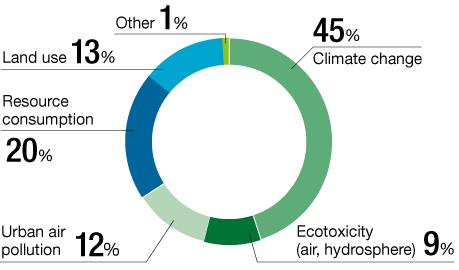
Note:Calculated from LIME2 by using IDEAv2
Negative Impacts on Natural Capital
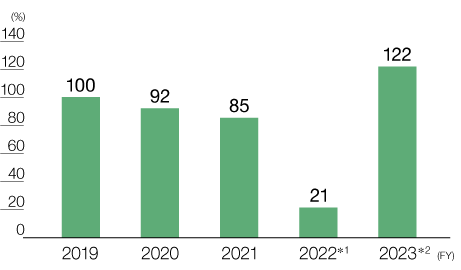
*1In fiscal 2022, the deconsolidation of materials- and construction-related companies resulted
in a significant decrease.
*2In fiscal 2023, consolidation of an energy-related company resulted in a significant increase.
Signing the Call to Action Statement, Initiated by Business for Nature
In 2020, the global Business for Nature coalition issued a Call to Action*1 statement. The aim was to encourage policy makers around the world to adopt policies to “reverse nature loss in this decade.” Hitachi Ltd. agrees with this goal and has signed the statement.
*1The Call to Action states that healthy societies, resilient economies, and thriving businesses rely on nature. The statement urges governments to adopt policies to reverse the loss of nature, and calls for the protection, restoration, and sustainable use of natural resources.
Business for Nature’s Call to Action30 by 30 Alliance for Biodiversity Approved by Ministry of the Environment (MOE), Japan

The 30 by 30 target aims to conserve or protect at least 30% of the land and sea areas in Japan by 2030 to achieve nature-positive goals of curbing biodiversity loss and encouraging restoration by the same year.
The 30 by 30 Alliance for Biodiversity was established to promote achievement of the 30 by 30 target agreed to at the G7 Summit 2021 and consists of governments, companies, and NPOs. The goals of the alliance are to expand national parks, register satochi-satoyama landscapes and commercial forests (areas of biodiversity preservation planned by various organizations) in international databases, pursue conservation in such areas, and share information concerning these activities.
Hitachi, Ltd. supports this mission and will work to advance related efforts.
In October 2023, “Kyōsō-no-Mori,” one of our research and development sites located in Kokubunji city, Tokyo, was officially certified as a Natural Symbiosis Site (an area where biodiversity is protected) by the Japanese government. In February 2024, the Hitachi Group’s Mito Works and the Woodlands of Hitachi High-Tech Science, an area within the grounds of group company Hitachi High-Tech Science Corporation’s Fuji Oyama Works, were awarded the same certification.
Natural Symbiosis Sites Certified by the Ministry of the Environment
Natural Symbiosis Sites are an initiative by the Ministry of the Environment aimed at achieving Nature Positive goals. Starting in fiscal 2023, the ministry began recognizing areas such as corporate forests, satoyama (mountain villages and forests), and urban green spaces managed by private entities, where biodiversity conservation is actively pursued, as Natural Symbiosis Sites. These recognized areas, excluding overlaps with protected regions, are registered as Other Effective area-based Conservation Measures (OECM) in the international database, and go toward achieving the 30by30 target.
In fiscal 2023, Hitachi had three sites recognized as Natural Symbiosis Sites.
| Company Name | Site Name | Location | Site Overview |
|---|---|---|---|
| Hitachi, Ltd. | Kokubunji Site: Kyoso-no-Mori | Kokubunji City, Tokyo | Primary vegetation includes dogwood, sawara cypress, and konara oak. The site features a variety of natural environments, such as springs, ponds, natural forests, bamboo groves, and grasslands, creating a diverse ecosystem that supports a wide range of species. |
| Hitachi Group Mito Business Sites | Hitachinaka City, Ibaraki Prefecture | The naturally occurring tall red pine trees have been preserved in a way that closely resembles the original forest at the time the Works was established. Additionally, in the greenbelt known as the Sagiyama area, large forests, primarily consisting of Japanese bay and hackberry trees—vegetation believed to represent the area’s potential natural vegetation—are being systematically maintained and managed. | |
| Hitachi High-Tech | Woodlands of Hitachi High-Tech Science | Oyama Town, Sunto District, Shizuoka Prefecture | Efforts are being made to manage and conserve the green spaces within the site to create a forest rich in biodiversity. Initiatives include
|
Addressing Risks Related to Water and Biodiversity
Approach & Policy
Activities
Since Hitachi’s exposure to water risks in businesses varies by region and type of business, it is important to identify respective risks and implement countermeasures. To facilitate risk response, we compiled the procedures for water risk identification and countermeasures under the Water Risk Guidelines*1, which are followed by some 100 manufacturing sites around the world that we classify as Category A in our environmental management classification.
We use our ESG Management Support Service (ESG-MSS) and various globally recognized tools for water risk assessment, in addition to region- and operation-specific water risk identification checklists. We use these data and checklists to identify and evaluate the water risks for each business unit and group company by country and region, and for the entire group once a year.
In recent years, the TNFD, an international information disclosure framework, has indicated that the perspective of biodiversity is also important in identifying and assessing water risks. Therefore, we conduct risk assessments specific to biodiversity by identifying and analyzing specific biodiversity-related data using tools such as the Water Risk Filter*2 and the water risk identification checklist.
Based on the results of these assessments, we pursue more effective risk reduction activities related to water risk and biodiversity.
*1Prepared with reference to Setting Site Water Targets Informed By Catchment Context created by members of the UN Global Compact, the CEO Water Mandate, the Pacific Institute, WRI, WWF, and other global institutions with the aim of helping companies set effective site water targets.
*2A water risk assessment tool developed by the World Wide Fund for Nature (WWF) and the German Development Finance Institution (DEG)
Identification of Water Risks Using the ESG Management Support Service (ESG-MSS)
| Regional Water Risks | Operational Water Risks | |||
|---|---|---|---|---|
| Risks Related to Biodiversity | Risks Related to Biodiversity | |||
| Number of Evaluation Items related to Water Resources, Water Quality, Water Damage, Regulations, Reputational Risk, etc. | Approximately 50 | 5 (included in the left column) | Approximately 70 | 13 (included in the left column) |
| Risk Identification Method | Various water risk assessment tools, including Aqueduct*1, Water Risk Filter, and Flood Hazard Map of the World*2, are combined to identify risks based on address information | Water Risk Filter | Risks identified using information such as a business site’s volume of water intake and effluents discharged, and water-related initiatives | Identifying risks related to biodiversity based on information on water intake and wastewater discharge at business sites |
| Risk Assessment | Assessed using a five-level scale*3 from low to extremely-high | Assessed using a five-level scale*3 from low to extremely-high | Assessed using a five-level scale*3 from low to extremely-high | Assessed using a five-level scale*3 from low to extremely-high |
| Risk Results | High at 8 sites | High at 7 sites | Low to low-medium at all sites, including the 8 to the left | Low to medium-high at all sites, including the 7 to the left | No business sites face an overall high water risk. |
*1A water risk assessment tool developed by the World Resources Institute (WRI).
*2Flood risk maps published by the European Union.
*3Five-level scale: low, low-medium, medium-high, high, extremely-high
Achievements in Fiscal 2023
In fiscal 2023, we assessed the water and biodiversity risks in each region and identified water risk as high at a total of 8 business sites operating in India, Egypt, Brazil, and Vietnam from among manufacturing sites classified as Category A in our environmental management classification. Additionally, 7 business sites operating in Italy, the United States of America, Germany, Czech Republic, Columbia, and Brazil were identified as having high risk related to biodiversity.
As a result of evaluating the operational water and biodiversity risks, all business sites, including the previously identified high-risk business sites, were found to have medium-high or lower operational risks related to water and biodiversity risks.
For this reason, Hitachi believes that none of our business sites faces overall high water or biodiversity risks.
Water usage at the 8 business sites with high regional water risks was 0.4 million m3, accounting for about 4% of the 11 million m3 of water used in Hitachi’s main manufacturing processes.
Understanding Water Risks in the Supply Chain
Hitachi believes it is important to understand the water risks faced by procurement partners to ensure stable procurement of parts and products.
In fiscal 2023, we used the Aqueduct and the Water Risk Filter to identify regional water risks for about 2,133 of our environmental focus partners of fiscal 2023 (about 3,000 companies were selected based on transaction history and country of operation.) About 2,100 of these partners responded to our survey regarding environmental initiatives, and we shared the results with relevant internal departments. Moving forward, we will strive to understand the water risks of our procurement partners further by expanding the scope of the survey.
Managing Chemical Substances
Approach & Policy
Hitachi believes that the control and reduction of chemical substances such as volatile organic compounds (VOCs), one of the causes of urban air pollution, are important not only for reducing discharge of pollutants into the air and water, but also for managing chemical substance usage properly to minimize our impact on natural capital.
Based on this belief, Hitachi formulated the Environment and CSR-Based MONOZUKURI Standards to manage chemical substances at all stages of its operations—from design, development, and procurement, to production, quality assurance, and shipping. We divide chemical substances in our products into two categories: prohibited substances and controlled substances. These categories facilitate separate management to respond to legal and regulatory frameworks at shipping destinations. With regard to chemical substances used in our business operations, we reduce risk by assigning three ranks to the use of such substances: prohibited, reduced, and controlled. We also educate chemical substance handlers and managers on laws, regulations, and proper risk assessment.
Managing Chemical Substances in Our Products
Activities
Hitachi designates the chemical substances in our products requiring management as Voluntarily Controlled Chemical Substances. We model the standards of the EU, where regulations are stringent, to identify and manage controlled chemical substances regardless of export destination, type of industry, or purpose of use.
We revise the list of managed substances and management levels when necessary, based on updates to the EU’s REACH*1 and other regulations. Our aim is to add substances to our list of Voluntarily Controlled Chemical Substances six months before such substances are regulated officially. For example, we revised the list in accordance with the new regulation of Dechlorane Plus and UV-328 as part of the POPs Convention*2, which will be effective from February 2025.
*1REACH: The European Union regulation of Registration, Evaluation, Authorisation, and Restriction of Chemicals.
*2POPs Convention: Stockholm Convention on Persistent Organic Pollutants.
Voluntarily controlled chemical substances in Hitachi Group productsClassification Examples
Prohibited Substances (Level 1)
Substances for which use in products (including packaging) is generally prohibited inside and outside Japan, but which might be found in products from suppliers.
Controlled Substances (Level 2)
Substances we are required to track and manage and substances requiring attention for recycling or appropriate disposal methods.
Managing Chemical Substances in Our Business Operations
Activities
Hitachi cuts emissions of chemical substances from factories and other sites through stricter levels of management, including expanding the number and scope of chemical substances subject to reduction*1.
We translate case studies on reduction into English and Chinese, sharing these cases globally among Hitachi Group companies. We also follow legally prescribed procedures in measuring and managing emissions*2 of sulfur oxides (SOx) and nitrogen oxides (NOx), and biochemical oxygen demand (BOD) and chemical oxygen demand (COD), measurements for which are required under the laws and regulations of our business site locations. At the same time, we continue efforts to restrict emissions further.
In fiscal 2023, which was the midpoint of the Environmental Action Plan for 2024 (fiscal 2022–fiscal 2024), we achieved a reduction rate of 22% toward the target of reducing atmospheric emissions of chemical substances per unit by 6% compared with a base year of fiscal 2010. To reduce the emissions, we are switching from paints containing VOCs to water-soluble and powder paints, and expanding the use of said paints, while altering the painting and washing processes.
*1Chemical substances subject to reduction: A total of 50 substances selected in terms of hazard and atmospheric emissions. Approximately 100% of substances in fiscal 2023 results were classified as VOCs.
*2Emissions: Calculated using data by business site (measured values, exhaust volume, content rate, water effluents discharged, etc.).
Inputs and Discharges of Chemical Substances During Business OperationsEnvironmental Action Plan for 2024 Management Values
Reduction Rate in Atmospheric Emissions of Chemical Substances per Unit (Hitachi Group)
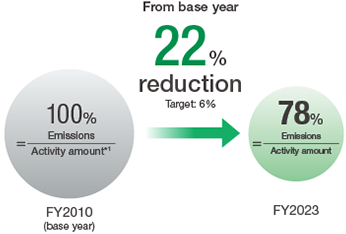
*1Activity amount is a value closely related to atmospheric emissions of chemical
substances at each business site (for example, substances handled, sales,
and output)
Reducing Atmospheric Emissions of Chemical Substances
(Hitachi Group)
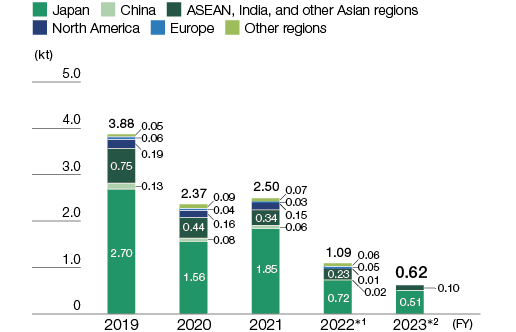
Note:Atmospheric emissions of VOCs and other chemical substances are calculated from the content rate included in the materials, etc.
*1Fiscal 2022 includes the atmospheric emissions of chemical substances from auto parts-related companies which became a consolidated subsidiary in fiscal 2020. Amount decreased significantly due to the deconsolidation of the materials and construction machinery companies.
*2Fiscal 2023, amount decreased due to the deconsolidation of auto parts-related companies.
Efforts to Conserve Ecosystems
Approach & Policy
Activities
At Hitachi, we seek to reduce negative impacts on natural capital caused by business activities and to promote positive impacts, including social contribution activities to protect nature and products and services that help preserve the ecosystem. In this way, we intend to minimize our impact on natural capital by fiscal 2050.
In addition, Hitachi created an Ecosystem Preservation Activities Menu citing specific activities to preserve the ecosystem. This chart includes activities that are difficult to quantify but are nonetheless important, such as the protection of rare species and efforts to make biodiversity a benchmark when making investment decisions. Each business site sets goals and pursues initiatives based on the Ecosystem Preservation Activities Menu to create a harmonized society with nature.
Ecosystem Preservation Activities Menu
| Category | Activities | No. of Menu Items | |
|---|---|---|---|
| Business Sites | Production | Reduce the use of resources that cannot be reused | 4 |
| Transportation | Use packaging that takes the ecosystem into consideration | 7 | |
| Collection, disposal, and recycling | Reduce hazardous materials in products | 2 | |
| Product planning, development, and design |
Estimate the impact of R&D on biodiversity during the product life cycle and implement mitigation measures, if needed | 3 | |
| Site management | Use native species and establish biotopes | 17 | |
| Water use | Use rain water | 1 | |
| Value Chain | Investment and acquisition |
Confirm the impact on biodiversity when investing in or acquiring a business, and implement measures to minimize such impacts | 1 |
| Market entry and expansion |
Include biodiversity as an investment benchmark | 1 | |
| Business development | Develop products and services to purify water, air, and soil and expand such businesses | 1 | |
| Procurement | Procure paper and other office supplies with a bias for products that take biodiversity into consideration | 17 | |
| Transportation | Implement ballast water measures during marine transportation | 2 | |
| Sales | Expand the sales of products that take biodiversity into consideration | 9 | |
| Collection, disposal, and recycling | Reuse and recycle components | 7 | |
| Entire value chain | Pursue the use of renewable energy | 1 | |
| Community | Engagement | Promote employee activities outside the company | 3 |
| Social contribution | Conduct desert greening and afforestation activities | 12 | |
| Water Use that takes Watershed Ecosystems into Consideration | Intake | Observe and collect biota information (impact on ecosystem depending on intake volume) | 14 |
| Discharge | Establish biota management indicators and make observations (species and numbers of inhabiting organisms) | 14 |
Note:Hitachi normally refers to suppliers (including vendors and providers) as procurement partners, with whom we build business together on an equal footing.